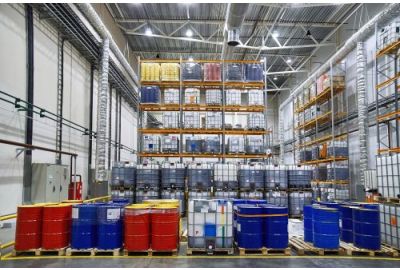Whether you need engine oil for a vehicle or fleet, metalworking fluids for your manufacturing process or any other type of lubricant, there are several considerations you should make regarding handling and storing lubricants in a workplace.
Employing best practices can enable you to maximise the shelf life of lubricants, save money with careful application, and make your processes more efficient, but it can also prevent health and safety issues and help businesses to meet their legal obligations. In the UK, the Health and Safety Executive (HSE) provides guidance for employers on mitigating risks and implementing suitable policies. The risks associated with oils and greases mean that it is vital for employers to manage lubricant storage in a manner that is compliant with guidance and reduces the likelihood of an accident or injury.
Here, the experts at Broughton Lubricants explain the considerations that workplaces must make to ensure that lubricants are stored safely, applied effectively, and comply with any relevant legal requirements. For advice on choosing a product for a particular application or guidance on the best storage and handling practices for your specific circumstances, call us today on 03300 555 655 or use the online enquiry form on this page to request a call back.
What are the best practices for lubricant storage?
The primary challenge for most workplaces that store lubricants is that workers need easy access to them, but these products can take up a lot of space and pose certain health and safety risks.
Ideally, containers should be stored horizontally on racks wherever possible. To preserve the lifespan of lubricants, they should be stored indoors in areas where temperatures remain stable. Even lubricant products that are purposefully designed to function in extreme hot, cold, or fluctuating temperatures should be stored in a stable and moderate climate. Outdoor storage is not usually suitable as products will be exposed to the elements, and this can reduce their expected shelf life. If storing lubricants outdoors is your only option, make sure to shelter them as best you can from inclement weather.
When storing lubricants indoors, make sure they are not exposed to contaminants like dust, which can cause chemical degradation and significantly reduce how effectively products operate.
How can I optimise conditions for stored lubricants?
The first step is relatively simple but is often forgotten: make sure to check the manufacturer's storage recommendations. While the general advice we have provided may be applied to most lubricants, a manufacturer will offer more detail and may have specific suggestions tailored to a particular product or application. This could extend the shelf life of an oil or grease and ensure it continues to operate at peak function.
If your business uses multiple lubricants for different applications, this can create risks of cross-contamination. Different combinations of additives make many lubricants incompatible with each other, and applying the wrong product can neutralise the effects of lubrication, damage equipment or delay production.
A proper labelling system is a useful way to keep lubricants stored safely and ensure they are used correctly. By colour coding labels, you can eliminate confusion and make it fast and easy for workers to identify which product should be used for which application. This can also be used to demarcate products that should only be used by workers with specific training. While lubricants themselves do not usually pose a high risk, workers may need training or guidance for certain applications, or to use specific dispensing equipment.
A final consideration is to ensure that you have enough lubricant for your application. Much the same as applying the wrong lubricant, not using enough oil or grease for your machinery can cause damage when running your general processes. How much lubricant you need will also affect storage, as it may determine the size of the containers you purchase.
Are there risks with lubricant handling?
The biggest risks associated with lubricant handling are spills, which significantly increase the risk of accidents and injuries. Slips, trips and falls are among the most common accidents reported by employers to the HSE each year. In many cases, employers are found to be responsible for these accidents if they have failed to meet HSE obligations and successfully mitigate risk.
In most cases, petroleum-based lubricant products do not pose a risk of chemical burns, skin irritation or other health and safety issues. Nevertheless, appropriate equipment should be provided to reduce any risk of exposure. Wherever necessary, employers should provide personal protective equipment and specialised training, to help workers manage lubricants effectively and avoid the risk of spills or other accidents.
If you need advice on safety and best practices for a specific application or product, contact the experts at Broughton Lubricants. Call us on 03300 555 655 or use the online enquiry form on this page to request a call back at your convenience.




